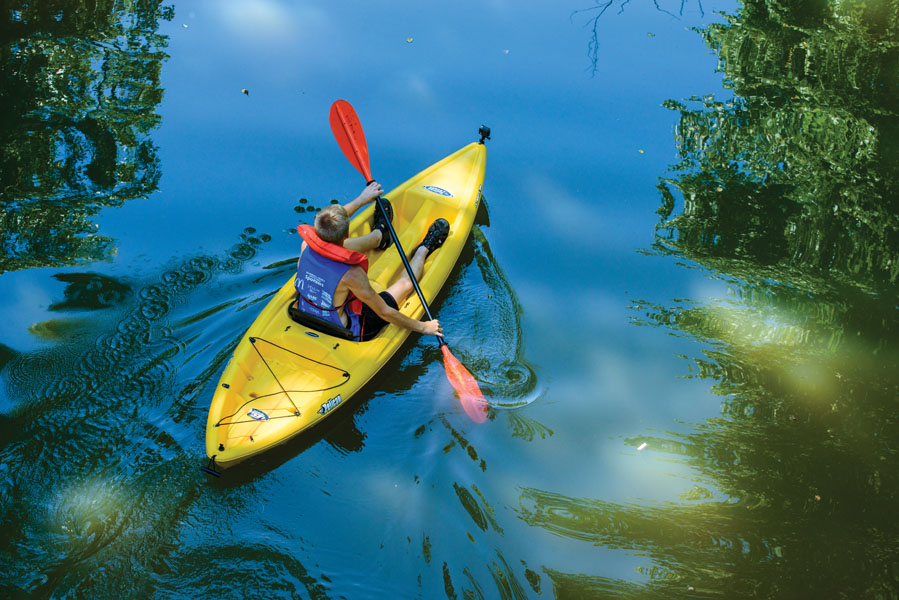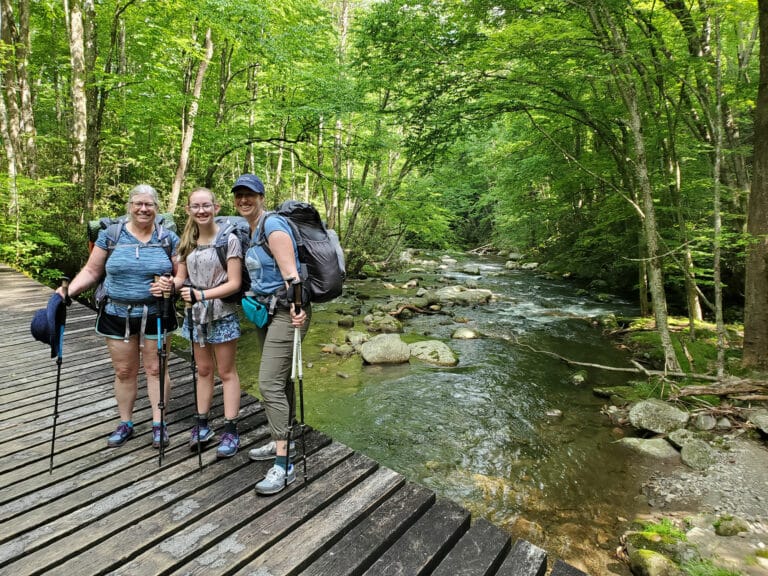The Adventure Stimulus Package
You can’t afford to fly to Tanzania to summit Mount Kilimanjaro. The ski trip to Switzerland is out this year too. I know, it sucks, but times are lean and plane fares, overpriced guides, and fruity umbrella drinks have been cut from your budget.Here’s the bright side: just because it’s fiscally irresponsible to travel halfway across the world to climb a mountain doesn’t mean you can’t partake in big adventure. You just need to spend less, which means staying close to home. Look no further than the Blue Ridge Mountains: we have peaks tougher to climb than 14ers, bridges you can parachute from, whitewater that pros drool over, epic bike rides that will make you quiver—all within a few hours’ drive. We’ve assembled the 10 Biggest Adventures in the Southeast. These are life-list items—outings you need to tick off before your ticker expires.
1. Hike the A.T. through the Smokies
Thru-hikers almost unanimously agree that the 72 miles of Appalachian Trail through the Great Smoky Mountains National Park are the most spectacular. The Smokies section features the highest elevations along the entire trail (you’ll bounce around the mile-high mark for much of the trip), arguably the most primitive views in the South (surrounded by the national park, there is no development as far as the eye can see), and some of the toughest climbs and descents along the trail.
“It’s constant up and down at the southern end of the park,” says Lee Lewis, head guide for the Smoky Mountain Outfitters in Gatlinburg. “You climb, hit a ridge, then drop, hit a gap, then climb. You’re praying for flat ground. If you can do the A.T. through the Smokies and you still like yourself, you can probably do the entire A.T.”
The diversity of rugged terrain and beauty along this section of the A.T. is unparalleled in the South, making it the quintessential backpacking trip for backcountry enthusiasts. Most hikers choose to hike the trail from south to north. Tough climbs in the southern end of the park lead to views of Fontana Lake. The crowds gather around Newfound Gap, where the trail crosses Highway 441 near Clingman’s Dome, but on the northern end of the trail near Davenport Gap, you’re likely to have the A.T. all to yourself.
“Even standing in the crowds at Clingman’s Dome, you get the feeling that you’re in the middle of nowhere,” Lewis says. “You’re standing on top of the Smokies, and there’s nothing man-made within sight. Just ridge after ridge of beautiful mountains.”
Attainable Alternative: Don’t have the time to thru-hike the Smokies? Summit Mount LeConte instead. LeConte rises a mile above the town of Gatlinburg at its base, offering more elevation gain from base to summit than any other mountain on the East Coast. The 5,301 feet you’ll climb from Gatlinburg to the peak is more elevation than you’d gain climbing some 14,000-foot peaks out West. Five trails climb to the summit—some are better than others. For the full summit experience, take Rainbow Falls Trail, which gains 4,000 feet in just over 6 miles. It’s rocky, steep, and less crowded than other summit trails like Alum Cave and Boulevard.
2. Bike the Blue Ridge Parkway
Make no mistake about it, the Blue Ridge Parkway was created for automobiles. The 469-mile two-lane highway curves along the spine of the Blue Ridge Mountains, stretching from Virginia’s Shenandoah National Park to the Great Smoky Mountains National Park in North Carolina. It was a Civilian Conservation Corps project designed to make the Appalachian Mountains more accessible to the growing number of car owners. But pedal the length of the Parkway on two skinny tires, and you’d swear the road was built for bicyclists.
“It’s a dream. Low traffic, nice surface, and beautiful scenery the entire length of the road,” says Bruce Bokish, a Raleigh-based cyclist who thru-biked the Parkway in 2007. “To say you rode the Blue Ridge Parkway, that means something to other cyclists. It’s like a hiker saying he hiked the A.T.”
That’s not to say biking the Parkway is a walk in the park. Most cyclists plan for an eight-day trip and pedal from north to south, but either direction you choose, prepare to pedal uphill most of the time.
“You have to have your mind set that you’re going to climb all day. You’ll be on some hills for three or four hours, then speed down the descents and hit the next hill. You’ll end up spending 80 percent of your day climbing,” Bokish says. “It’s as hard core as you can get in one week.”
Planning a thru-bike of the Parkway is relatively simple. With only one road, getting lost is difficult. The biggest factor you have to consider is figuring out where to stop each night. There are long stretches of road without access to civilization, so you have to be honest with yourself regarding the number of miles you can put in during a single day and plan accordingly. And factor in the extra weight necessary for this kind of trip.
“I had 40 pounds of gear on my bike,” Bokish says. “It made the climbs tougher, but the extra weight made my bike feel stable on the descents. Flying through 270-degree sweeping turns at 45 mph was pure thrill.”
Attainable Alternative: Can’t bike the entire Blue Ridge Parkway? Then tackle Skyline Drive, the northern portion of the Parkway that cuts through the heart of Shenandoah National Park. The scenery is top notch along the 105-mile stretch, and restaurants and lodges abound. The biggest gap between services is 25 miles, and the grades are relatively easy, making it the ideal road for your first bike tour. nps.gov/shen.
3. Run Mountain Masochist
If you’re a trail runner in the Southeast, there’s really only one goal you should be working toward. Finishing the Mountain Masochist 50 Mile Trail Run. The original Southern mountain ultra, the Mountain Masochist was designed almost 30 years ago by running legend David Horton to bring big mountain pain and suffering to the Southern Appalachians. It’s been a fixture on the national race scene ever since. Some even say it’s the best trail race in the East. The Masochist is so well respected, Montrail even named a shoe after it. And it could be the only ultra to inspire a folk song.
“The Mountain Masochist is the country’s preeminent 50-mile trail run, so great runners are attracted to this run,” says Eric Grossman, the 2008 MMTR winner and overall course record holder. “Many of those great runners get spanked by the course, like I did when I first ran it in 1998. I didn’t run another step for two years.”
Suffering is the goal of this 50-miler, which is actually about 54 miles long and full of long climbs up forest roads that equal 9,000 feet of elevation gain. Horton designed the race to push its competitors, so there are harsh cut-off times at all 16 aid stations and an overall time limit of 12 hours, which means there’s very little time for walking. Highlights from the race include a 6:30 a.m. start time enabling runners to enjoy the sunrise along the trail, a massive climb up Buck Mountain where volunteers blast the Rocky theme, inspirational messages from the Bible scattered throughout the course, a fun, technical singletrack section known as “the loop,” and the finish line. Because if you finish the MMTR in Horton’s allotted time, you’ve truly accomplished something.
Attainable Alternative: A 50-mile mountain run not your idea of a fun Saturday? Run the Springmaid Splash in Spruce Pine, N.C. instead. You have 10K and 5K options through the mountains of Western North Carolina on one of the wildest and wettest short race courses in the Southeast. You’ll cross the river four times during the 10K. Not creek. River. Aug. 22. mitchellraces.com.
4. Climb Looking Glass Rock
Looking Glass is different than other mountains. It stands out along the ridgeline–the one gray, rocky hump in a line of green peaks. According to geologists, Looking Glass was almost a volcano, but the rock cooled off before it could erupt. Lucky for us. After centuries of erosion, the mountain is now a dome of white granite almost three miles long, boasting 500-foot long climbing routes that rise into the great blue sky above Pisgah National Forest. The mountain houses a variety of climbs: face, crack, overhanging, even some fun top roping and sport routes, but it’s known primarily for its stellar trad options.
“You can’t come down here without your trad game on,” says Marcus Webb, a climber who’s been ticking off routes on Looking Glass since his days at nearby Brevard College. The variety of long, exhausting routes that take copious amounts of gear combined with the unparalleled scenery from the rock has turned Looking Glass into a classic destination for southern rock addicts.
“The moves are cool and intense and the exposure is great,” Webb says. “No matter what face you’re climbing, you get panoramic views.”
Guides like the mountain because of the variety of easy to intermediate routes on the south face, and experienced climbers love it because of the intense test pieces scattered across the entire mountain. If you want the quintessential Looking Glass experience, climb The Nose, a 5.8 four-pitch trad route with fun, ladder-like moves and lots of eyebrows–a big, chunky hold that’s indicative of Looking Glass. It’s a long route with massive exposure and perhaps the best lunch spot on any climbing route in the Southeast. After the third pitch, there’s the Parking Lot, a ledge with awesome views that’s big enough to park a VW bus on.
Attainable Alternative: Scared of heights but still want to sample classic Southern rock? Try bouldering Grandmother Mountain near Linville, N.C. Grandmother is a massive boulder field containing hundreds of problems, including a number of options for beginners. These massive quartzite boulders are what put Boone on the climbing map. Try Pulling Teeth (V4), a fun overhanging problem with big handholds.
For more thrills with fewer skills, rappel down the New River Gorge. Several outfitters in Fayetteville can guide you safely from rim to river.
5. Jump off the New River Bridge on Bridge Day
Let’s get one thing straight: we’re not telling you to jump off the New River Bridge. Okay, we are. But we’re not telling you to roll into Fayetteville, W.Va. and leap from the bridge on a dare. We’re telling you to follow the rules. Learn the art of BASE jumping, and then jump off the New River Bridge for an 876-foot parachute-guided fall to the bottom of the gorge. Hundreds of people do it every year, so why not you?
Bridge Day is the single biggest BASE jumping event in the world, attracting BASE enthusiasts from all over the world for six hours of gravity-fed fun. The New River Bridge is the highest bridge east of the Mississippi and one of only two places where BASE jumping is legal in the United States. It’s a gorgeous setting: a 1,700 foot long steel arch bridge spanning one of the most beautiful gorges in the U.S. Jumping off the New River Gorge Bridge is only legal on Bridge Day, which puts this adventure at the top of the list for most adrenaline junkies.
Is it dangerous? Absolutely. According to a study performed by Stavinger University, you’re five times more likely to get seriously injured BASE jumping than you are skydiving. Blame the lower altitudes, which leave no room for jumper error. Three people have died at Bridge Day since its inception in 1981. But thousands have jumped off the bridge, and in 2008, out of the 383 people that jumped off the bridge during Bridge Day, only three were taken to the hospital.
West Virginia native Burton Erwin was the first person to jump off the New River Bridge on August 1, 1979. The first legal Bridge Day jump was held in 1981. A handful of jumpers made the leap. A year later, 30 jumpers showed up. Then 100. By 1984, 350 jumpers leapt from the bridge. Today, 250,000 spectators flood the bridge every year to watch the colorful jumpers plummet to the bottom of the gorge.
Attainable Alternative: BASE jumping not your thing? Then cliff jump Jack’s River Falls. A 20-foot high boulder juts from the water at the base of the impressive Jack’s River Falls, all of which is sandwiched inside the Cohutta Wilderness in North Georgia. It’s scenic, remote, and exhilarating.
6. Kayak the Green River Narrows
The Green isn’t just a river, it’s a way of life. Thanks to frequent dam releases, the Green runs over 200 days a year, making it the only consistent class V steep creek in the country. A number of elite paddlers have made Western North Carolina their home, simply because of the Green’s technical challenge and consistent water. “The Green played a huge part in my moving to Asheville,” says Chris Gragtmans, a pro boater, filmmaker, and Green fixture. “I wouldn’t be the athlete that I am today without that river.”
The Narrows—a three-mile section of the Green—features 11 major rapids, including a half-mile section that drops 422 feet through a steep, narrow, boulder-choked gorge. It is the most famous whitewater run in the Southeast, and the scene of one of the most respected kayak races in the country, the Green Race. Paddlers train all year for this early November carnage-fest, which attracts top-notch talent.
On the day of the race, hundreds of spectators line the gorge to watch pro kayakers style the Green’s infamous rapids. Special attention is given to Gorilla, a technical class V+ that includes a four-foot wide notch that channels the entire river over a 20-foot drop.
“The race only takes four minutes and thirty seconds,” Gragtmans says. “But it’s incredibly difficult to link up all those rapids in succession to take a victory. It’s the most challenging kayak race I know of.”
Gragtmans would know. In 2008, he won the Ironman category of the Green Race, which means he fought those rapids twice, once in a long boat and once in a short boat.
Attainable Alternative: Can’t paddle the Green? Then raft the Gauley. One million gallons of water surge through the Gauley gorge per minute during fall release season, turning the Gauley into the quintessential big water river. Raft the Upper Gauley, nine miles of continuous whitewater with 40 named rapids, including five that are class V.
7. Hang Glide Lookout Mountain
Lookout Mountain stretches for 20 miles along the border of Georgia and Tennessee. It is a long plateau that stands about 1,000 feet above its surroundings. And people come from all over the country to jump off of it.
“There’s nothing like running off the side of a mountain,” says Jen Richards, the operations manager for Lookout Mountain Flight Park, the largest hang gliding school in America. “The first time you do it, it’s a life-changing event.”
More often than not, people choose Lookout Mountain as the location of that life-changing event. Lookout’s combination of topography, weather, and the school’s facilities (a massive concrete takeoff ramp and a 44-acre landing zone), make it one of the best hang gliding locales in the country. Richards says the long, flat ridgeline of Lookout allows for extended flight times, even for novices. Experienced pilots have flown 100 miles from the mountain’s edge.
If you’re new to the hang gliding game, don’t fret. The Flight Park operates a series of training hills, like bunny slopes, to ease people into the sport. Start on a small hill and soar for 10 feet, then move to the bigger hill. Repeat until you’re jumping off the concrete platform off the northwest edge of Lookout and soaring 2,000 feet above Chattanooga.
But how safe is it to jump off a mountain strapped to some aluminum and fabric?
“Like every other adventure, hang gliding is as safe as you make it,” Richards says. “But statistically, we’re the safest form of flight.”
So safe, that in the 20 years that Lookout Mountain Flight Park has offered tandem flights, they’ve never had one tandem accident.
Attainable Alternative: Can’t hang glide off Lookout? Then walk the Swinging Bridge at Grandfather Mountain. The 228-foot long suspension bridge stands at 5,305 feet above sea level and spans an 80-foot chasm. Huge views of the Linville River Valley, 1,600 feet below, can be had from the bridge.
8. Run a Southeastern Marathon
The Southeast and Mid-Atlantic have an abundance of top-notch marathons. The largest and oldest is the Marine Corps Marathon, which reaches its 30,000 participant cap quickly. If you’re lucky enough to get in, you’ll enjoy a 26.2-mile foot tour of national monuments. The flat course and flawless race organization make it ideal for first-timers (like Oprah Winfrey in 1994). Marines line the course, offering support, working aid stations, and gathering at the finish to hand out medals. The 34th annual Marine Corps Marathon takes place Oct. 25, 2009.
The Richmond Marathon is also one of the South’s largest and most popular marathons. Like Marine Corps, it’s celebrated for its flat, fun, spectator-friendly course. Richmond fans line the streets, and they don’t just come out to clap and offer a few words of encouragement. They come out to party. The Richmond Marathon’s festive atmosphere includes live music along the course and officially designated “Party Zones.” The marathon’s loop course takes runners across the James River and through Richmond’s historic neighborhoods. Miles 17 and 23 even feature junk-food stations with gummy bears, cookies, and Coca-Cola. Only a few hills are sprinkled throughout the course, and a downhill finish helps runners muster a final kick for the cheering fans. Around 5,000 runners will toe the Richmond starting line on Nov. 14, 2009.
Attainable Alternative: Don’t have it in you to go 26.2? Run the Peachtree Road Race instead. The 10K distance isn’t what makes this race epic; it’s the people. 55,000 runners converge on downtown Atlanta for the biggest 10K in the world. atlantatrackclub.org.
9. Bike the Shenandoah Mountain 100
You like to ride bikes? You like to ride bikes for 100 miles over a mountain half a dozen times? You like to ride bikes for 100 miles over a mountain half a dozen times and drink beer with other like-minded (sick) individuals? Then the Shenandoah Mountain 100 is for you. In the past ten years, the SM100 has grown from a quirky, locals-in-the-know punish fest into a quirky, who-do-I-have-to-bribe-to-get-a-place-at-the-starting-line punish fest. Some mountain bikers plan their entire year around this 100-mile race.
“It may just be February right now,” says Sam Koerber, a pro biker with Gary Fisher’s 29er Crew who placed second at last year’s SM100. “But I find it hard not to look forward to the SM100 already.”
The race course takes 500 lucky bikers up and down the Promised Land of singletrack: Shenandoah Mountain in the George Washington National Forest. You’ll climb about 14,000 feet, some of which will be technical, some of which will be fire roads. But when the climbing gets tough, remember the mountain bikers’ mantra: “What goes up, must come down.” The descents are long, technical, flowing, and predominantly singletrack, including the 7-mile downhill along Chestnut Ridge toward the end of the race that some competitors say is the highlight of the course.
But how do you keep yourself fresh enough to enjoy those long downhills at the end of the race? According to Koeber, you draft.
“The SM100 brings some of the tactics and drama of road racing to mountain biking, including drafting. The key to doing well in a race of this distance is efficiency,” Koeber says. “Over 100 miles, a little tension in the arms or face translates to calories burned and lactic acid created. You have to pay attention to the subtleties. Eating and drinking become an art form and drafting is key.”
Attainable Alternative: Can’t pedal the Shenandoah Mountain 100? Try biking Canaan Valley, W.Va., arguably the Mountain State’s fat tire epicenter. The valley boasts some of the most technical singletrack on the east coast along with some of the most scenic forest roads and rail trails. For a challenge, pedal Plantation Trail—16 miles of technical roots, rocks, and swamp. For a relaxing cruise, hit Blackwater Canyon Rail Trail, a 10-mile easy downhill through Blackwater Canyon.
10. Trek the Linville Gorge
It’s almost a cliché to call a gorge the “Grand Canyon of the East.” Just about every ditch east of the Mississippi tries to lay claim to this title. But if any gorge deserves this overused distinction, it’s the Linville Gorge inside the Pisgah National Forest in Western North Carolina. Linville is an oasis of undeveloped wilderness sandwiched between Grandfather Mountain and Lake James State Park. The 12,000-acre tract of land was one of the few areas in the Southeast that qualified for Wilderness status back in ’64 because the landscape was too rugged for loggers to access. As a result, you’ve got a 14-mile gorge with no signs of development except for a handful of hiking trails. No roads, no bridges, no logging grades, just rock cliffs that stretch 1,000 feet toward the sky, a whitewater river punctuated by massive boulders, and some seriously rugged hiking trails.
“It really is as wild as you can get,” says Jason Berry, the general manager of Footsloggers in nearby Boone. “You get down there and you won’t see another person. You won’t even hear any traffic. Do you realize how rare that is to find on the East Coast?”
An end-to-end trek of the gorge is the quintessential Wilderness adventure trip. You’ll find un-named waterfalls, deep swimming holes, peregrine falcons, and ultimately, solitude. Access the gorge on the west side, where Kistler Memorial Highway parallels the rim. Pick up the Linville Gorge Trail from the highway and hike south as the trail cuts through the heart of the gorge paralleling the river for 11 miles. Campsites abound along the river, but the forest service only gives you two nights to camp, so don’t get too comfortable (permits are mandatory). A number of trails will take you back to the top of the western rim, but for the longest trip, follow the Linville Gorge Trail to Pitch-In Trail, the southernmost path that climbs out of the gorge. Expect steep grades in and out of the gorge as well as difficult navigation along the river. There are no trail signs and user-created paths and aggressive underbrush make navigation difficult. As a result, dozens of hikers get lost inside the gorge every year.
“You can’t go on autopilot inside the gorge,” Berry says. “You’ve got to have a map and compass and you have to always pay attention and keep your wits about you.”
Attainable Alternative: Don’t want to risk getting lost in Linville Gorge but still want to commune with undisturbed nature? Head into the Joyce Kilmer-Slickrock Wilderness to commune with some of the largest old growth trees in the Southeast. Hike the two-mile Joyce Kilmer National Recreation Trail to reach giant yellow poplars that measure 20 feet in circumference and 100 feet tall. •








